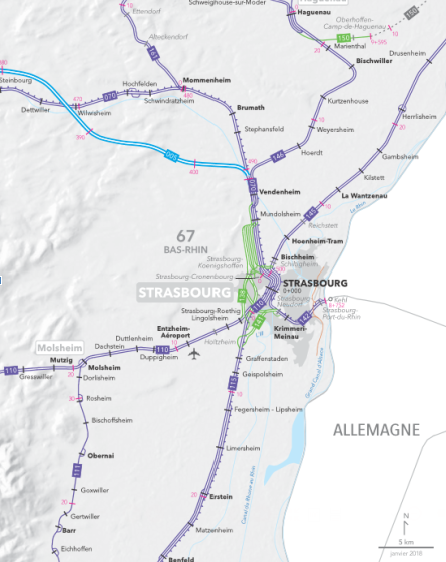Train Director - Strasbourg 2016 |
Simulation: Strasbourg 2016
 Published on 20/10/31
Published on 20/10/31
 Download the simulation (1.7 MB)
Download the simulation (1.7 MB)
 Author: Clément Debrie
Author: Clément Debrie
 647 trains 62 stations
647 trains 62 stations
 Train Director Version: 3.9
Train Director Version: 3.9
This scenario shows the railway network in Bas-Rhin, in the North of Alsace in France, updated to 2016 to take into account the newly opened high-speed line to Paris. Strasbourg-Ville station is the main station of the city and located at the center of the regional network.
Infrastructures:
The European East LGV was fully opened in July 2016. This additional high speed track towards Paris is reserved for TGVs and is the main difference from the previous 2014 layout! This opening obviously led to re-scheduling the whole northern services in Bas-Rhin. The line is connected to the classical one at Vendenheim station, just where the Haguenau embranchment is too. Therefore TGVs no longer have to take the switches before Vendenheim in order to go on the classical line. They can reach 320 km/h on this modern fast train line - Paris is only 1h50 (~ 450 km, 406 of them on LGV) away from Strasbourg. It is headed to Paris-Est and linked to the other French LGVs near Paris.
The lines in Strasbourg’s sector are briefly described to understand the different paths taken by the trains in the scenario. The Alsace-Moselle region switched between France and Germany several times in the last 150 years. It was part of the German Second Empire between 1871 and 1918. This has still a visible consequence on the railway structures today as, in contrast to the rest of France, trains drive on the right. Interregional lines are equipped with special infrastructure allowing trains to switch between tracks when they enter or leave Alsace-Moselle.
Strasbourg is the end station, at kilometer 502, of one of the main radial French lines starting from Paris, namely the line “from Noisy-le-Sec to Strasbourg-Ville”, usually referred as the Paris-Strasbourg line. This double-tracked line was built between 1849 and 1852 and electrified one century later with 25 kV-50 Hz, as all northern French main lines. Starting from Strasbourg, the line is straight oriented to the North till it reaches Brumath station and turns westward. The line serves Saverne, crosses the Vosges mountains, thus leaving Alsace, and then reaches Sarrebourg and Nancy. The other big city of Lorraine region, Metz, is also accessible thanks to an embranchment just before Sarrebourg. In the first 20 kilometers, 3 embranchments are connected to the main line:
Despite the heavy traffic between Strasbourg and Mundolsheim, only 3 direct tracks are dedicated to passenger trains. They can be used in both ways.
In the South, Strasbourg is the head of 3 double-tracked lines that separate right after the station.
Strasbourg’s station itself has 9 classic tracks ; 4 additional tracks that can only be used by trains departing to or arriving from the North and named 30, 31, 32 and 33 ; and one additional track used only by pendular international trains linking Strasbourg to Offenburg in Germany. Eventually, passing freight trains can use an additional line avoiding the station and linking northern and all southern lines together.
Exploitation:
Strasbourg is exploited as the destination/origin of almost every regional train in Bas-Rhin. These are the regular lines for passenger traffic, in the same order as the infrastructures used were presented below...
Since 2014, the Alsace region bought new Regiolis trains that would eventually replace the old RRR couches towed by BB25000 or BB67000 locomotives that you can see in
the Strasbourg2014 scenario.
The schedules of the freight trains are fully fictional. Their number was estimated thanks to statistics published by SNCF. I do not guarantee that none of them will interfere with passengers trains
TGVs serve Strasbourg towards Paris, Rennes, Nantes, Bordeaux, Lille, Bruxelles and Luxembourg via the LGV East and towards Colmar, Lyon, Montpellier and Marseille via the main southern line.
Advice:
The trains going northwards from Strasbourg can use the main line or the third track whose speed limit is lower (100 km/h instead of 130). So, this track should only be used when two trains leave on the same time. Special care should be given to the switches between Mundolsheim and Vendenheim.
The line between Strasbourg and Sélestat is double-tracked. There is a third track allowing fast trains to overtake slow local ones.
Schedule: 2016
Clément Debrie (debrieclement3b@yahoo.fr)
 English -
English -


